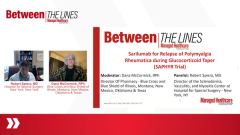
Key Patient Characteristics in the SAPHYR Trial
Robert Spiera, M.D., reviews key patient characteristics from the study of sarilumab in refractory polymyalgia rheumatica.
Episodes in this series

This is a video synopsis/summary of a Between the Lines involving Robert Spiera, M.D., and Dana McCormick, R.Ph.
Dana McCormick, R.Ph., and Robert Spiera, M.D., discuss a study on refractory polymyalgia rheumatica patients. The demographics mirrored typical polymyalgia rheumatica profiles, averaging 70-year-old Caucasians, primarily females, with an extensive steroid history spanning nearly a year pretrial. The study, conducted in Europe, highlighted minimal data supporting methotrexate use due to steroid-resistant cases.
Patients experienced morning stiffness and maintained a mean glucocorticoid dose of 10 milligrams/day for about 300 days, indicating substantial steroid exposure. Despite some methotrexate usage, primarily in the placebo arm, its efficacy remained uncertain, prompting skepticism in its application for this condition.
Spiera elucidated crucial trial outcomes, emphasizing sarilumab’s superiority over placebo. Patients on active sarilumab were three times more likely to sustain remission by week 52, with significantly lower steroid exposure. Additionally, sarilumab-treated patients showed fewer flares post-remission, lower glucocorticoid toxicity and reduced reliance on rescue therapies; 84% didn’t require additional steroids.
Although only 28% met the stringent primary remission goal, other positive outcomes, such as minimal disease flare and avoidance of rescue therapy, showcased sarilumab’s substantial clinical benefits beyond the primary measure, underlining its potential significance in treating polymyalgia rheumatica.
This summary was AI-generated and reviewed by Managed Healthcare Executive® staff.
Newsletter
Get the latest industry news, event updates, and more from Managed healthcare Executive.















































